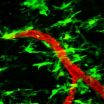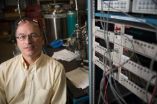(Press-News.org) WASHINGTON - The hydraulic system of trees is so finely-tuned that predicted increases in drought due to climate change may lead to catastrophic failure in many species. A recent paper co-authored by George Washington University Assistant Professor of Biological Sciences Amy Zanne finds that those systems in plants around the globe are operating at the top of their safety threshold, making forest ecosystems vulnerable to increasing environmental stress.
In the current issue of the journal Nature, Dr. Zanne and lead authors from the University of Western Sydney in Australia and Ulm University in Germany, report that the hydraulic system trees depend on is a unique but unstable mechanism that is constantly challenged.
"Drought is a major force shaping our forests," said Dr. Zanne, a faculty member within the Columbian College of Arts and Sciences. "Over the last century, drought has been responsible globally for numerous large-scale forest diebacks. To make effective predictions of how forest landscapes may change in the future, we need to first understand how plants work."
The primary challenge plants face during drought is how to keep their plumbing working. Drought stress creates trapped gas emboli in the water system, which reduces the ability of plants to supply water to leaves for photosynthetic gas exchange and can ultimately result in desiccation and death.
"Vulnerability to embolism is one of the main factors determining drought effects on trees," Dr. Zanne said. "However, plants vary dramatically in their resistance to drought-induced embolism, which has made predictions of how forests might be altered under future climates more difficult."
While the research findings are alarming, plants do have a few other tricks up their sleeves. They may have some flexibility of changing their plumbing or new species of trees may replace species no longer capable of persisting in a given place.
An international team consisting of Dr. Zanne and 23 other plant scientists organized via the ARC-NZ Research Network for Vegetation Function at Macquarie University in Sydney, Australia, analyzed existing measures of plant hydraulic safety thresholds in forest species around the world.
The surprising result that the group discovered is that while plants vary greatly in their embolism resistance, they are sitting at similar safety thresholds across all forest types. The team found these thresholds are largely independent of mean annual precipitation.
The findings explain why drought-induced forest decline occurs in arid as well as wet forests, which had historically not been considered at risk.
###
George Washington University
In the heart of the nation's capital with additional programs in Virginia, the George Washington University was created by an Act of Congress in 1821. Today, GW is the largest institution of higher education in the District of Columbia. The university offers comprehensive programs of undergraduate and graduate liberal arts study, as well as degree programs in medicine, public health, law, engineering, education, business and international affairs. Each year, GW enrolls a diverse population of undergraduate, graduate and professional students from all 50 states, the District of Columbia, and more than 130 countries.
Increasing drought stress challenges vulnerable hydraulic system of plants, GW professor finds
Amy Zanne, Assistant Professor of Biological Sciences, co-authors paper published in Nature studying effects of drought on plant life
2012-11-28
ELSE PRESS RELEASES FROM THIS DATE:
GSA Today: Human transformation of land threatens future sustainability?
2012-11-28
Boulder, Colorado, USA - Social and physical scientists have long been concerned about the effects of humans on Earth's surface -- in part through deforestation, encroachment of urban areas onto traditionally agricultural lands, and erosion of soils -- and the implications these changes have on Earth's ability to provide for an ever-growing population. The December 2012 GSA Today science article presents examples of land transformation by humans and documents some of the effects of these changes.
Researchers Roger Hooke of the University of Maine, USA, and José F. Martín-Duque ...
Resolving conflicts over end-of-life care: Mayo experts offer tips
2012-11-28
ROCHESTER, Minn. -- It's one of the toughest questions patients and their loved ones can discuss with physicians: When is further medical treatment futile? The conversation can become even more difficult if patients or their families disagree with health care providers' recommendations on end-of-life care. Early, clear communication between patients and their care teams, choosing objective surrogates to represent patients and involving third parties such as ethics committees can help avoid or resolve conflicts, Mayo Clinic experts Christopher Burkle, M.D., J.D., and Jeffre ...
How to buy an ethical diamond
2012-11-28
BUFFALO, N.Y. -- You've already decided that you're going to pop the question. Now comes another quandary: Where to get the ring, if you're buying one?
The holidays are a busy time for engagements, and Trina Hamilton, a University at Buffalo expert in corporate responsibility, says socially minded consumers have a lot to think about when it comes to finding the right rock.
In recent years, shoppers have turned to Canadian diamonds as news reports and movies exposed the diamond trade's role in fueling armed conflicts in developing countries. (Think "Blood Diamond," the ...
East Asia faces unique challenges, opportunities for stem cell innovation
2012-11-28
Tension is the theme running through the new consensus statement issued by the Hinxton Group, an international working group on stem cell research and regulation. Specifically, tension between intellectual property policies and scientific norms of free exchange, but also between eastern and western cultures, national and international interests, and privatized vs. nationalized health care systems.
The consensus, titled Statement on Data and Materials Sharing and Intellectual Property in Pluripotent Stem Cell Science in Japan and China, was released on the Hinxton Group's ...
Reducing sibling rivalry in youth improves later health and well-being
2012-11-28
UNIVERSITY PARK, Pa. -- Sibling conflict represents parents' number one concern and complaint about family life, but a new prevention program -- designed and carried out by researchers at Penn State -- demonstrates that siblings of elementary-school age can learn to get along. In doing so, they can improve their future health and well-being.
"Negative sibling relationships are strongly linked to aggressive, anti-social and delinquent behaviors, including substance use," said Mark Feinberg, research professor in the Prevention Research Center for the Promotion of Human ...
NIH-funded researchers show possible trigger for MS nerve damage
2012-11-28
High-resolution real-time images show in mice how nerves may be damaged during the earliest stages of multiple sclerosis. The results suggest that the critical step happens when fibrinogen, a blood-clotting protein, leaks into the central nervous system and activates immune cells called microglia.
"We have shown that fibrinogen is the trigger," said Katerina Akassoglou, Ph.D., an associate investigator at the Gladstone Institute for Neurological Disease and professor of neurology at the University of California, San Francisco, and senior author of the paper published ...
Rocks, water, air, space ... and humans: An NSF recipe for AGU success
2012-11-28
The National Science Foundation is suggesting adding a bit of spice to a geophysical scientist's research recipe of rocks, water, air, space and life:
Humans.
At next month's Fall Meeting of the American Geophysical Union (AGU) a behemoth of a conference of nearly 20,000 Earth and space scientists, educators, students and policy makers, an international group of scientists will make the case for adding the human element to their research.
The International Network of Research in Coupled Human and Natural Systems – CHANS-Net – is supported by the National Science ...
Kentucky study finds common drug increases deaths in atrial fibrillation patients
2012-11-28
LEXINGTON, Ky. (Nov. 27, 2012) -- Digoxin, a drug widely used to treat heart disease, increases the possibility of death when used by patients with a common heart rhythm problem − atrial fibrillation (AF), according to new study findings by University of Kentucky researchers. The results have been published in the prestigious European Heart Journal, and raises serious concerns about the expansive use of this long-standing heart medication in patients with AF.
UK researchers led by Dr. Samy Claude Elayi, associate professor of medicine at UK HealthCare's Gill Heart ...
Scripps Research Institute study points to potential new therapies for cancer and other diseases
2012-11-28
LA JOLLA, CA – November 27, 2012 – Researchers at The Scripps Research Institute (TRSI) are fueling the future of cancer treatment by improving a powerful tool in disease defense: the body's immune system. By revealing a novel but widespread cell signaling process, the scientists may have found a way to manipulate an important component of the immune system into more effectively fighting disease.
The study, recently published online ahead of print by the journal Blood, shows that disabling a particular enzyme, called ItpkB, in mice improves the function of a type of immune ...
New thermoelectric material could be an energy saver
2012-11-28
By using common materials found pretty much anywhere there is dirt, a team of Michigan State University researchers have developed a new thermoelectric material.
This is important, they said, because the vast majority of heat that is generated from, for example, a car engine, is lost through the tail pipe. It's the thermoelectric material's job to take that heat and turn it into something useful, like electricity.
The researchers, led by Donald Morelli, a professor of chemical engineering and materials science, developed the material based on natural minerals known ...
LAST 30 PRESS RELEASES:
Support for parents with infants at pediatric check-ups leads to better reading and math skills in elementary school
Kids’ behavioral health is a growing share of family health costs
Day & night: Cancer disrupts the brain’s natural rhythm
COVID-19 vaccination significantly reduces risk to pregnant women and baby
The role of vaccination in maternal and perinatal outcomes associated with COVID-19 in pregnancy
Mayo Clinic smartwatch system helps parents shorten and defuse children's severe tantrums early
Behavioral health spending spikes to 40% of all children’s health expenditures, nearly doubling in a decade
Digital cognitive behavioral treatment for generalized anxiety disorder
Expenditures for pediatric behavioral health care over time and estimated family financial burden
Air conditioning in nursing homes and mortality during extreme heat
The Alps to lose a record number of glaciers in the next decade
What makes a good proton conductor?
New science reporting guide published for journalists in Bulgaria
New international study reveals major survival gaps among children with cancer
New science reporting guide published for journalists in Turkey
Scientists develop a smarter mRNA therapy that knows which cells to target
Neuroanatomy-informed brain–machine hybrid intelligence for robust acoustic target detection
Eight SwRI hydrogen projects funded by ENERGYWERX
The Lundquist Institute and its start-up company Vitalex Biosciences Announces Strategic Advancement of Second-Generation fungal Vaccine VXV-01 through Phase 1 Trials under $40 Million Competitive Con
Fine particles in pollution are associated with early signs of autoimmune disease
Review article | Towards a Global Ground-Based Earth Observatory (GGBEO): Leveraging existing systems and networks
Penn and UMich create world’s smallest programmable, autonomous robots
Cleveland researchers launch first major study to address ‘hidden performance killer’ in athletes
To connect across politics, try saying what you oppose
Modulating key interaction prevents virus from entering cells
Project explores barriers to NHS career progression facing international medical graduates
Jeonbuk National University researchers explore the impact of different seasonings on the flavor perception of Doenjang soup
Two Keck Medicine of USC Hospitals named Leapfrog Top Teaching Hospitals
World-first discovery uncovers how glioblastoma tumours dodge chemotherapy, potentially opening the door to new treatments
A fatal mix-up: How certain gut bacteria drive multiple sclerosis
[Press-News.org] Increasing drought stress challenges vulnerable hydraulic system of plants, GW professor findsAmy Zanne, Assistant Professor of Biological Sciences, co-authors paper published in Nature studying effects of drought on plant life



